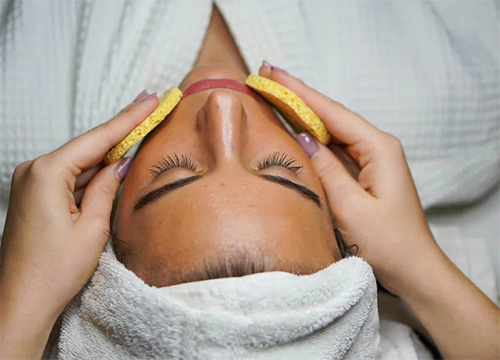
After many studies, it was found that hyaluronic acid also has antioxidant properties, which means that your skin has a built-in protective shield against free radicals that you cannot control, such as: B. Environmental pollution.
While this acid is actually part of the larger family of AHAs, it is most likely the only one that can provide reliable skin care results.
What does hyaluronic acid do for your skin?
As already mentioned, hyaluronic acid differs from other AHAs in that it is gentler on the skin.
Some benefits of hyaluronic acid for skin:
Reduces the appearance of fine lines and wrinkles and eliminates all signs of aging
Restores the water content of the skin barrier through unparalleled hydration
Improves the elasticity of the skin, allowing it to protect itself and fight toxins and free radicals
While hyaluronic acid cannot replace elastin in the skin, it can improve the appearance of sagging skin by providing firmness and improving facial contours.
Helps balance uneven skin texture and pigmentation.
While it does not help with skin cell renewal, it does support this process by adding moisture, making the cells appear more vibrant for longer.
By boosting your skin’s moisture balance, hyaluronic acid can control the amount of oil produced, which can reduce clogged pores and breakouts.
If all of this hasn’t made you want to dive into hyaluronic acid, I’ll now give you examples of how hyaluronic acid can be used, and which skin types can benefit from incorporating it into their daily skincare routine.
How to Use Hyaluronic Acid?
1. Find a Formula That’s Right for Your Skin Type
Hyaluronic acid is primarily found in water-based and oil-based serums. This means you can tailor your serum to your skin type. For example, dry skin will benefit more from using an oil-based serum, while oily skin types will get better results with a water-based serum.
Test the Product First
Hyaluronic acid is very gentle and can be used by all skin types. However, it’s important to take proper precautions when trying new products. Perform a patch test first, applying a small amount to an inconspicuous area, such as B. behind your ear for 24 hours to ensure your skin doesn’t react.
Apply Serum After Cleansing
Cleanse and tone your skin as usual, but apply hyaluronic acid before applying your moisturizer to ensure your skin is doubly hydrated.
Apply to damp skin
As already mentioned, hyaluronic acid loves to absorb moisture from the surrounding air. By applying hyaluronic acid to already damp skin, you give the acid a chance to absorb into the skin faster and retain moisture.
Use it day and night
Unlike glycolic acid, HA is not sensitive to UV rays, so you can use it morning and night. This helps your skin more than you think because you can combine hyaluronic acid with other products containing AHAs, BHAs, and retinols for optimal results.
You’ll be amazed at the results you see when you incorporate this skin-rejuvenating elixir into your entire skincare routine.
Which skin types need hyaluronic acid?
Everyone.
Yes, honestly, anyone can use hyaluronic acid. Unlike exfoliating AHAs, it doesn’t dry out the skin, and there’s no rest or worry. Just think of it as a big glass of water to wash your face.
Dry skin: You guessed it, this moisturizer for dry skin feels like a god-send. Blighted, dry, dull skin is restored to a plump, plump, and radiant complexion.
Oily and acne-prone skin types: Since hyaluronic acid works hard to balance your skin’s oil production, your skin will feel comfortable without having to worry about clogged pores or breakouts from using such a moisturizing product. If you have active pimples, you can rest assured that you won’t be adding extra bacteria and debris.
Dehydrated skin types: To be clear, all skin types can become dehydrated. Don’t assume that those new fine lines are a result of aging. In 99% of cases, your skin is just thirsty, and using hyaluronic acid can smooth out fine lines and leave skin looking smooth and healthy.
Sensitive skin types: If you haven’t researched AHAs yet, hyaluronic acid is a great place to start to balance your skin’s barrier and build a strong shield against free radicals, daily aggressors, and other toxins that can cause irritation.
Yes, no kidding, hyaluronic acid really does work wonders for all skin types!
What are the side effects of hyaluronic acid?
Hyaluronic acid is found in many skin care products, but many doctors also use it in eye surgeries and filler injections. There are some side effects that may occur when used in these areas, such as:
Sore throat
Dry eyes
Joint stiffness
Jaw and other joint pain
If you undergo any of the above procedures, your doctor will discuss all of these side effects with you.
As for side effects from topical use, the likelihood is very low but as with all new products, a patch test of at least 24 hours is a must to ensure that no reaction or skin irritation occurs.
With all the benefits this powerful ingredient has for the skin, it makes you wonder if there is room for anything else in your routine. But before you throw out any products, the beauty of HA is that it works amazingly on its own, but also in combination with other skin acids.
Because of its unknown ability to attract moisture to the surface of the skin, you may not need to use HA in more than one product, as your body also produces it naturally. To stimulate the production of the acid in your body, you can add antioxidant-rich fruits and vegetables to your diet. This is the easiest way to help your skin look youthful and plump. At least you can tell everyone that you’ve made HA your skincare secret!
Have you ever wondered how lactic acid works with hyaluronic acid in your skincare routine? Check out our guide to lactic acid to learn more about this AHA.


